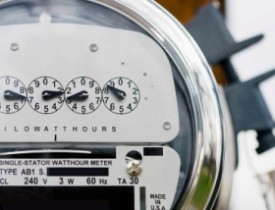How to Read an Electric Meter

In these difficult economic times, it's important to know that your money is being spent wisely and that the services you pay for are those that you receive. This also goes for your utilities company. With this in mind, let's go over a few pointers on how to read your electric meter so you can be certain that you're being charged correctly for your home's energy usage.
Location and Identification
Understanding how to read your meter starts with finding and identifying the type of meter your home has. You can normally locate your meter on the exterior end of your circuit board box. In newer homes, the box is typically in the garage, with the meter on the outside of the garage. However, in older homes, your circuit box could be almost anywhere. I've seen them in hallways, living rooms, above stairway landings - even bathroom closets.
Once you've found your meter, you can expect to find one of two different designs. The most common residential meters are the electromechanical analog meter and the solid-state digital meter.
Reading Your Meter
For an accurate monthly read, you require two pieces of information: the start of your monthly billing cycle and the last billed kilowatt hour from your meter. Both of these pieces of data can be found on your monthly utilities bill. Once acquired, note the starting kilowatt hour number from the first day of billing. At the end of your billing cycle, take a reading from your meter and subtract that kilowatt hour number from the first day of your billing cycle; now you have your total kilowatt usage for that particular month. Keep track of the last kilowatt hour of your billing cycle so that you can calculate again next month.
For example, assume you start your reading at 3492. After 30 days, at the end of your billing cycle, you now read 4332. Subtract your starting number from your end number and you'll have your total kilowatt usage for the month: 840. Now divide this number by the total number of days in your billing cycle (in this case, 30) and you'll have your daily kilowatt usage of 28.
Electromechanical Meter
With an electromechanical analog meter, you'll find either a dial with a rotating disc in the center or a cyclometer type, which displays kilowatt hours much like an odometer on a vehicle. Note that with a dial-pointer type, adjacent pointers typically rotate in opposite directions due to the gearing mechanism.
Solid-State Meter
With a solid-state digital meter, the reading of your meter is virtually the same as above, except there is a digital readout as opposed to a rotating dial/tick meter system. Many cities are moving to telemetry as a form of reading residential users' meters. Sending a secure signal at various intervals back to the utilities company with your current usage helps avoid the labor costs of a human meter reader and it removes the possibility of human error. In turn, this minimizes costs for the utilities company, which ideally will delay rate increases.
My city of residence recently completed a major overhaul of its residential electrical meter-reading systems, changing from a once-a-month human meter reader to an electronic readout system. This keeps the human error out of my meter reading, allowing for accurate charges on my monthly bill; plus, it saves the meter reader from having to deal with my dog once a month.
Following the aforementioned steps will put you on the path to being a more knowledgeable consumer, and it should give you the confidence to address any issues or concerns you may have regarding your bill or how much you're being charged. Good luck, and happy tracking!
Looking for a Pro? Call us (866) 441-6648

Electrical Average Costs
Electricians Experiences

Whole House Fan Installation Saves Me Money On Electricity

Pool Wiring Repair Eliminates A Potential Hazard



